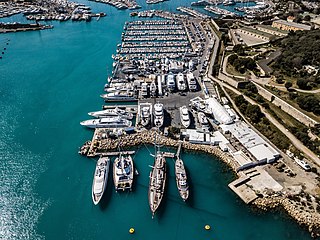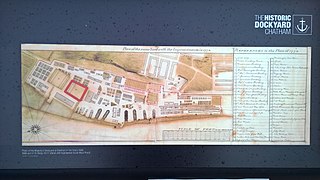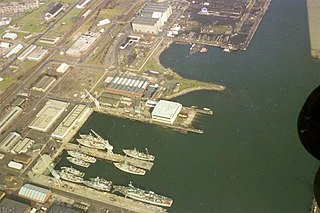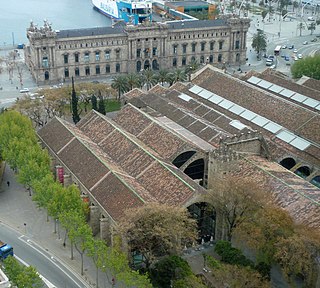Cartagena or Carthagena may refer to:

A shipyard is a place where ships are built and repaired. These can be yachts, military vessels, cruise liners or other cargo or passenger ships. Dockyards are sometimes more associated with maintenance and basing activities than shipyards, which are sometimes associated more with initial construction. The terms are routinely used interchangeably, in part because the evolution of dockyards and shipyards has often caused them to change or merge roles.

HMS Engadine was a 9,909 GRT cargo ship laid down at the Greenock Dockyard Company, Greenock, Scotland on 16 March 1940, launched on 26 May 1941 and completed on 17 November 1941.

Chatham Historic Dockyard is a maritime museum on part of the site of the former royal/naval dockyard at Chatham in Kent, South East England.

Rosyth Dockyard is a large naval dockyard on the Firth of Forth at Rosyth, Fife, Scotland, owned by Babcock Marine, which formerly undertook refitting of Royal Navy surface vessels and submarines. Before its privatisation in the 1990s it was formerly the Royal Naval Dockyard Rosyth. Its primary role now is the dismantling of decommissioned nuclear submarines. It is also the integration site for the Royal Navy's newest aircraft carriers, the Queen Elizabeth class as well as the Type 31 Frigate.

Her Majesty's Naval Base, Devonport is one of three operating bases in the United Kingdom for the Royal Navy and is the sole nuclear repair and refuelling facility for the Royal Navy. The largest naval base in Western Europe, HMNB Devonport is located in Devonport, in the west of the city of Plymouth, England.

HMS Expedition was a 70-gun third-rate ship of the line of the Royal Navy, launched at Portsmouth Dockyard on 10 September 1679.
HMS Suffolk was a 70-gun third-rate ship of the line of the Royal Navy, built by contract of 20 February 1678 by Sir Henry Johnson at his Blackwall Yard and launched in May 1680. Suffolk was commanded by Captain Wolfran Cornwall at the Battle of Beachy Head in 1690, and by Captain Christopher Billopp at the Battle of Barfleur in 1692.

HMS Boyne was an 80-gun third-rate ship of the line of the Royal Navy, launched at Deptford Dockyard on 21 May 1692.
HMS Shrewsbury was a three-decker 80-gun third-rate ship of the line of the Royal Navy, launched at Portsmouth Dockyard on the 6th of February, 1695.
HMS Ranelagh was a three-decker 80-gun third-rate ship of the line of the Royal Navy, launched at Deptford Dockyard on 25 June 1697. She took part in a number of actions during the War of the Spanish Succession, including the Battle of Vigo in 1702 and the Battle of Vélez-Málaga in 1704.

HMS Swiftsure was a 70-gun third-rate ship of the line of the Royal Navy, launched in 1755 and in active service during the Seven Years' War. After a distinguished career at sea she was decommissioned in 1763 and sold into private hands ten years later.

HMS Portland was a 50-gun fourth rate ship of the line of the Royal Navy, launched at Woolwich Dockyard on 28 March 1693.

HMS Burford was a 70-gun third rate ship of the line of the Royal Navy, built at Deptford Dockyard to the 1719 Establishment, and launched on 19 July 1722. Burford was notably the early posting of both John Forbes and John Byng, both of whom rose to become Admirals.

HMS Hampton Court was a 70-gun third-rate ship of the line of the Royal Navy, built at Rotherhithe according to the 1706 Establishment and launched on 19 August 1709.
HMS Salisbury was a 50-gun fourth rate ship of the line of the Royal Navy, built at Chatham Dockyard to the dimensions of the 1706 Establishment, and launched on 3 July 1707. In autumn of 1707, she brought the body of admiral Sir Cloudesley Shovell from St Mary's to Plymouth prior to his burial in Westminster Abbey.
HMS Tilbury was a 60-gun fourth-rate ship of the line of the Royal Navy, built at Chatham Dockyard to the dimensions of the 1719 Establishment, and launched on 2 June 1733.

The Spanish ironclad Tetuán was an armored frigate built in the royal dockyard at Ferrol during the 1860s for the Spanish Navy. She was captured by rebels during the Cantonal Revolution in 1873 and participated in the Battle off Cartagena. While under repair after the battle, the ship was destroyed by fire and broken up in 1874.

Rayo was an 80-gun ship of the line of the Spanish Navy. As was traditional for Spanish ships not named after a saint, its second, dedicatory name was San Pedro Apóstol. She underwent rebuilding at Cartagena from 1803 to 1805, emerging as a three-decked ship with 100 guns. She then fought at the Battle of Trafalgar during the Napoleonic Wars and was dismasted as a result of damage sustained in the battle. When she sortied after Trafalgar in order to recover prizes, the warship was captured by HMS Donegal. Subsequently, she ran aground and was wrecked in a storm. Her broken hull was set ablaze and destroyed by British sailors on 31 October.

The Barcelona Royal Shipyard is a shipyard and former military building of Gothic architecture placed at the Port Vell area of the Port of Barcelona. Nowadays it houses the Barcelona Maritime Museum. Construction started during the 13th century under the rule of Peter III of Aragon. During excavations in 2012 it was discovered that in the late 16th century a new building was constructed on top of the old medieval dockyard, giving the building its current structure. This excavations also uncovered a Roman graveyard. The shipyard's restoration was finished in early 2013. The museum was reopened in 2014.













